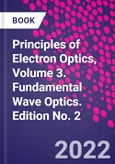Principles of Electron Optic: Volume Three: Wave Optics, discusses this essential topic in microscopy to help readers understand the propagation of electrons from the source to the specimen, and through the latter (and from it) to the image plane of the instrument. In addition, it also explains interference phenomena, notably holography, and informal coherence theory. This third volume accompanies volumes one and two that cover new content on holography and interference, improved and new modes of image formation, aberration corrected imaging, simulation, and measurement, 3D-reconstruction, and more.
The study of such beams forms the subject of electron optics, which divides naturally into geometrical optics where effects due to wavelength are neglected, with wave optics considered.
Please Note: This is an On Demand product, delivery may take up to 11 working days after payment has been received.
Table of Contents
54. Introduction
Part XI
Wave Mechanics
55. The Schr�dinger Equation
56. The Relativistic Wave Equation
57. The Eikonal Approximation
58. Paraxial Wave Optics
59. The General Theory of Electron Diffraction and Interference
60. Elementary Diffraction Patterns
Part XII, Electron Interference and Electron Holography
61. General Introduction
62. Interferometry
63. Holography
Part XIII, Theory of Image Formation
64. General Introduction
65. Fundamentals of Transfer Theory
66. The Theory of Bright-field Imaging.
67. Image Formation in the Scanning Transmission Electron Microscope
68. Statistical Parameter Estimation Theory
Part XIV
Electron-specimen Interactions
69. Electron Interactions in Thin Specimens
Part XV
Digital Image Processing
70. Introduction
71. Acquisition, Sampling and Coding
72. Enhancement
73. Linear Restoration
74. Nonlinear Restoration
the Phase Problem
75. Three-dimensional Reconstruction
76. Image Analysis
77. Microscope Parameter Measurement and Instrument Control
Part XVI
Coherence, Brightness and Spectral Functions
78. Coherence and the Brightness Functions
79. Wigner Optics
PART XVII
Vortex Studies, the Quantum Electron Microscope
80. Orbital Angular Momentum, Vortex Beams and the Quantum Electron Microscope








